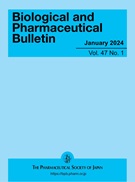
- 5 号 p. 878-
- 4 号 p. 750-
- 3 号 p. 549-
- 2 号 p. 345-
- 1 号 p. 1-
- |<
- <
- 1
- >
- >|
-
Naoko Yoshida2024 年 47 巻 5 号 p. 878-885
発行日: 2024/05/01
公開日: 2024/05/01
ジャーナル フリー HTMLThe existence of substandard and falsified medicines threatens people’s health and causes economic losses as well as a loss of trust in medicines. As the distribution of pharmaceuticals becomes more globalized and the spread of substandard and falsified medicines continues worldwide, pharmaceutical security measures must be strengthened. To eradicate substandard and falsified medicines, our group is conducting fact-finding investigations of medicines distributed in lower middle-income countries (LMICs) and on the Internet. From the perspective of pharmaceutics, such as physical assessment of medicines, we are working to clarify the actual situation and develop methods to detect substandard and falsified medicines. We have collected substandard and falsified medicines distributed in LMICs and on the Internet and performed pharmacopoeial tests, mainly using HPLC, which is a basic analytic method. In addition to quality evaluation, we have evaluated the applicability of various analytic methods, including observation of pharmaceuticals using an electron microscope, Raman scattering analysis, near-IR spectroscopic analysis, chemical imaging, and X-ray computed tomography (CT) to detect substandard and falsified medicines, and we have clarified their limitations. We also developed a small-scale quality screening method using statistical techniques. We are engaged in the development of methods to monitor the distribution of illegal medicines and evolve research in forensic and policy science. These efforts will contribute to the eradication of substandard and falsified medicines. Herein, I describe our experience in the development of detection methods and elucidation of the pharmaceutical status of substandard and falsified medicines using novel technologies.
 抄録全体を表示PDF形式でダウンロード (4984K) HTML形式で全画面表示
抄録全体を表示PDF形式でダウンロード (4984K) HTML形式で全画面表示 -
Kahori Shimizu2024 年 47 巻 5 号 p. 886-894
発行日: 2024/05/01
公開日: 2024/05/01
ジャーナル フリー HTMLThe number of patients with lifestyle-related diseases such as type 2 diabetes mellitus (T2DM) and metabolic dysfunction-associated steatotic liver disease (MASLD), formerly known as non-alcoholic fatty liver disease (NAFLD), has continued to increase worldwide. Therefore, development of innovative therapeutic methods targeting lifestyle-related diseases is required. Gene therapy has attracted considerable attention as an advanced medical treatment. Safe and high-performance vectors are essential for the practical application of gene therapy. Replication-incompetent adenovirus (Ad) vectors are widely used in clinical gene therapy and basic research. Here, we developed a novel Ad vector, named Ad-E4-122aT, exhibiting higher and longer-term transgene expression and lower hepatotoxicity than conventional Ad vectors. We also elucidated the mechanisms underlying Ad vector-induced hepatotoxicity during the early phase using Ad-E4-122aT. Next, we examined the therapeutic effects of the genes of interest, namely zinc finger AN1-type domain 3 (ZFAND3), lipoprotein lipase (LPL), and lysophospholipid acyltransferase 10 (LPLAT10), on lifestyle-related diseases using Ad-E4-122aT. We showed that the overexpression of ZFAND3 in the liver improved glucose tolerance and insulin resistance. Liver-specific LPL overexpression suppressed hepatic lipid accumulation and improved glucose metabolism. LPLAT10 overexpression in the liver suppressed postprandial hyperglycemia by increasing glucose-stimulated insulin secretion. Furthermore, we also focused on foods to advance research on the pathophysiology and treatment of lifestyle-related diseases. Cranberry and calamondin, which are promising functional foods, attenuated the progression of MASLD/NAFLD. Our findings will aid the development of new therapeutic methods, including gene therapy, for lifestyle-related diseases such as T2DM and MASLD/NAFLD.
 抄録全体を表示PDF形式でダウンロード (4706K) HTML形式で全画面表示
抄録全体を表示PDF形式でダウンロード (4706K) HTML形式で全画面表示 -
Yue Zhou, Jun-ichiro Takahashi, Hiroaki Sakurai2024 年 47 巻 5 号 p. 895-903
発行日: 2024/05/01
公開日: 2024/05/01
ジャーナル フリー HTMLEpidermal growth factor (EGF)–EGF receptor (EGFR) signaling studies paved the way for a basic understanding of growth factor and oncogene signaling pathways and the development of tyrosine kinase inhibitors (TKIs). Due to resistance mutations and the activation of alternative pathways when cancer cells escape TKIs, highly diverse cell populations form in recurrent tumors through mechanisms that have not yet been fully elucidated. In this review, we summarize recent advances in EGFR basic research on signaling networks and intracellular trafficking that may clarify the novel mechanisms of inhibitor resistance, discuss recent clinical developments in EGFR-targeted cancer therapy, and offer novel strategies for cancer drug development.
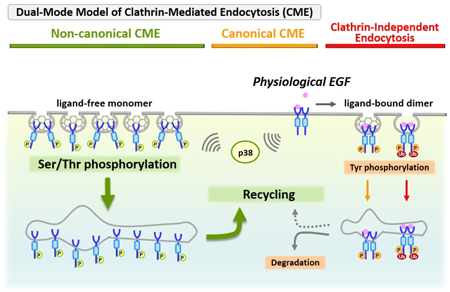 抄録全体を表示PDF形式でダウンロード (2179K) HTML形式で全画面表示
抄録全体を表示PDF形式でダウンロード (2179K) HTML形式で全画面表示
-
Kohji Noguchi2024 年 47 巻 5 号 p. 904
発行日: 2024/05/01
公開日: 2024/05/01
ジャーナル オープンアクセス HTMLPDF形式でダウンロード (178K) HTML形式で全画面表示
-
Naoki Kishimoto, Shogo Misumi2024 年 47 巻 5 号 p. 905-911
発行日: 2024/05/01
公開日: 2024/05/01
ジャーナル フリー HTMLViruses require host cells to replicate and proliferate, which indicates that viruses hijack the cellular machinery. Human immunodeficiency virus type 1 (HIV-1) primarily infects CD4-positive T cells, and efficiently uses cellular proteins to replicate. Cells already have proteins that inhibit the replication of the foreign HIV-1, but their function is suppressed by viral proteins. Intriguingly, HIV-1 infection also changes the cellular metabolism to aerobic glycolysis. This phenomenon has been interpreted as a cellular response to maintain homeostasis during viral infection, yet HIV-1 efficiently replicates even in this environment. In this review, we discuss the regulatory role of glycolytic enzymes in viral replication and the impact of aerobic glycolysis on viral infection by introducing various host proteins involved in viral replication. Furthermore, we would like to propose a “glyceraldehyde-3-phosphate dehydrogenase-induced shock (G-shock) and kill strategy” that maximizes the antiviral effect of the glycolytic enzyme glyceraldehyde 3-phosphate dehydrogenase (GAPDH) to eliminate latently HIV-1-infected cells.
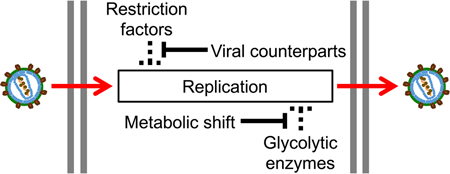 抄録全体を表示PDF形式でダウンロード (958K) HTML形式で全画面表示
抄録全体を表示PDF形式でダウンロード (958K) HTML形式で全画面表示 -
Yuki Iwaisako, Masahiro Fujimuro2024 年 47 巻 5 号 p. 912-916
発行日: 2024/05/01
公開日: 2024/05/01
ジャーナル フリー HTMLThe human herpesviruses (HHVs) are classified into the following three subfamilies: Alphaherpesvirinae, Betaherpesvirinae, and Gammaherpesvirinae. These HHVs have distinct pathological features, while containing a highly conserved viral replication pathway. Among HHVs, the basic viral particle structure and the sequential processes of viral replication are nearly identical. In particular, the capsid formation mechanism has been proposed to be highly similar among herpesviruses, because the viral capsid-organizing proteins are highly conserved at the structural and functional levels. Herpesviruses form capsids containing the viral genome in the nucleus of infected cells during the lytic phase, and release infectious virus (i.e., virions) to the cell exterior. In the capsid formation process, a single-unit-length viral genome is encapsidated into a preformed capsid. The single-unit-length viral genome is produced by cleavage from a viral genome precursor in which multiple unit-length viral genomes are tandemly linked. This encapsidation and cleavage is carried out by the terminase complex, which is composed of viral proteins. Since the terminase complex-mediated encapsidation and cleavage is a virus-specific mechanism that does not exist in humans, it may be an excellent inhibitory target for anti-viral drugs with high virus specificity. This review provides an overview of the functions of the terminase complexes of HHVs.
 抄録全体を表示PDF形式でダウンロード (764K) HTML形式で全画面表示
抄録全体を表示PDF形式でダウンロード (764K) HTML形式で全画面表示 -
Yuichiro Yamamoto, Tetsuya Inoue2024 年 47 巻 5 号 p. 917-923
発行日: 2024/05/01
公開日: 2024/05/01
ジャーナル フリー HTMLThe global coronavirus disease 2019 (COVID-19) pandemic, caused by severe acute respiratory syndrome coronavirus 2 (SARS-CoV-2), has devastated public health and the global economy. New variants are continually emerging because of amino acid mutations within the SARS-CoV-2 spike protein. Existing neutralizing antibodies (nAbs) that target the receptor-binding domain (RBD) within the spike protein have been shown to have reduced neutralizing activity against these variants. In particular, the recently expanding omicron subvariants BQ 1.1 and XBB are resistant to nAbs approved for emergency use by the United States Food and Drug Administration. Therefore, it is essential to develop broad nAbs to combat emerging variants. In contrast to the massive accumulation of mutations within the RBD, the S2 subunit remains highly conserved among variants. Therefore, nAbs targeting the S2 region may provide effective cross-protection against novel SARS-CoV-2 variants. Here, we provide a detailed summary of nAbs targeting the S2 subunit: the fusion peptide, stem helix, and heptad repeats 1 and 2. In addition, we provide prospects to solve problems such as the weak neutralizing potency of nAbs targeting the S2 subunit.
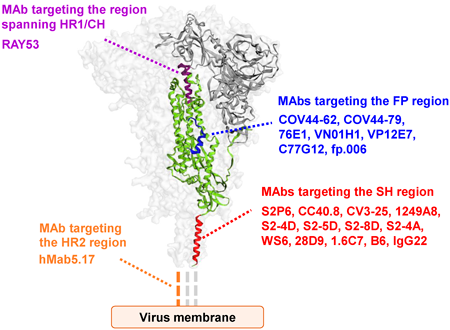 抄録全体を表示PDF形式でダウンロード (814K) HTML形式で全画面表示
抄録全体を表示PDF形式でダウンロード (814K) HTML形式で全画面表示
-
Hide Sasaki, Ryo Seoka, Mayuko Yagi, Jun Komano2024 年 47 巻 5 号 p. 924-929
発行日: 2024/05/01
公開日: 2024/05/01
ジャーナル フリー HTML
電子付録The region-to-region spread of human infectious diseases is considered to be dependent on the human mobility flow (HMF). However, it has been hard to obtain the evidence for this. Since the onset of the coronavirus disease 2019 (COVID-19) pandemic in Japan 2020, the government has enforced countermeasures against COVID-19 nationwide, namely the restriction of personal travelling, universal masking, and hand hygiene. As a result, the spread of acute respiratory infections had been effectively controlled. However, COVID-19 as well as pediatric respiratory syncytial virus (RSV) infections were not well-controlled. The region-to-region spread of pediatric RSV infections in 2020–2021 was recognizable unlike those in 2018 and 2019. In this study, we investigated the correlation between the trend of regional reports of the pediatric RSV infections and the HMF based on cellular phone signal data. Upon closer examination of both epidemiological trend and HMF data, the spread of pediatric RSV infection from one region to another was logically explained by HMF, which would serve as the evidence of the dependence of regional transmission on HMF. This is the first solid evidence where this correlation has been clearly observed for the common respiratory infections. While social implementation of infection control measures has successfully suppressed the droplet-mediated respiratory infections, such as influenza, but not the airborne infections, it was suggested that the aerosol transmission and adult asymptomatic carrier were involved in the transmission of RSV akin to COVID-19.
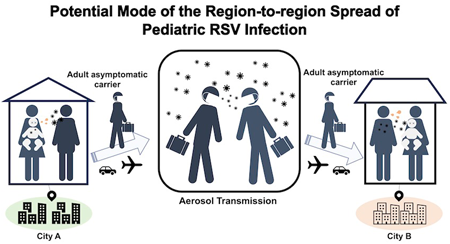 抄録全体を表示PDF形式でダウンロード (3313K) HTML形式で全画面表示
抄録全体を表示PDF形式でダウンロード (3313K) HTML形式で全画面表示 -
Mana Murae, Shota Sakai, Non Miyata, Yoshimi Shimizu, Yuko Okemoto-Nak ...2024 年 47 巻 5 号 p. 930-940
発行日: 2024/05/01
公開日: 2024/05/01
ジャーナル フリー HTML
電子付録The coronavirus disease 2019 (COVID-19) is caused by the etiological agent severe acute respiratory syndrome coronavirus 2 (SARS-CoV-2). COVID-19, with the recurrent epidemics of new variants of SARS-CoV-2, remains a global public health problem, and new antivirals are still required. Some cholesterol derivatives, such as 25-hydroxycholesterol, are known to have antiviral activity against a wide range of enveloped and non-enveloped viruses, including SARS-CoV-2. At the entry step of SARS-CoV-2 infection, the viral envelope fuses with the host membrane dependent of viral spike (S) glycoproteins. From the screening of cholesterol derivatives, we found a new compound 26,27-dinorcholest-5-en-24-yne-3β,20-diol (Nat-20(S)-yne) that inhibited the SARS-CoV-2 S protein-dependent membrane fusion in a syncytium formation assay. Nat-20(S)-yne exhibited the inhibitory activities of SARS-CoV-2 pseudovirus entry and intact SARS-CoV-2 infection in a dose-dependent manner. Among the variants of SARS-CoV-2, inhibition of infection by Nat-20(S)-yne was stronger in delta and Wuhan strains, which predominantly invade into cells via fusion at the plasma membrane, than in omicron strains. The interaction between receptor-binding domain of S proteins and host receptor ACE2 was not affected by Nat-20(S)-yne. Unlike 25-hydroxycholesterol, which regulates various steps of cholesterol metabolism, Nat-20(S)-yne inhibited only de novo cholesterol biosynthesis. As a result, plasma membrane cholesterol content was substantially decreased in Nat-20(S)-yne-treated cells, leading to inhibition of SARS-CoV-2 infection. Nat-20(S)-yne having a new mechanism of action may be a potential therapeutic candidate for COVID-19.
 抄録全体を表示PDF形式でダウンロード (7523K) HTML形式で全画面表示
抄録全体を表示PDF形式でダウンロード (7523K) HTML形式で全画面表示
-
Maki Ohkubo, Emiko Seo, Kosuke Doki, Yoshiharu Suzuki, Ikuo Sekine, Ma ...2024 年 47 巻 5 号 p. 941-945
発行日: 2024/05/10
公開日: 2024/05/10
ジャーナル フリー HTMLHepatitis B virus reactivation (HBV-R) is a serious complication that can occur in patients with resolved HBV infection during cancer chemotherapy. We examined the levels of HBV surface antibody (HBsAb) and HBV core antibody (HBcAb) to assess the incidence of HBV-R in cancer patients including hematopoietic stem cell transplantation (HSCT) and rituximab administration. This retrospective cohort study included 590 patients with resolved HBV infection. The incidence of HBV-R was evaluated 761.5 (range, 90–3898) days after the inititiation of chemotherapy. Of the patients, 13 (2.2%) developed HBV-R after the start of chemotherapy. All 13 patients exhibited lower HBsAb (<100 mIU/mL) levels at baseline. A higher level of HBcAb (≥100 cut off index (C.O.I.)) was a possible risk factor for HBV-R as well as HSCT and rituximab administration. The simultaneous presence of HBsAb <100 mIU/mL and HBcAb ≥100 C.O.I. increased the risk of HBV-R by 18.5%. Patients treated with rituximab were at a higher risk of HBV-R (18.4%) despite having HBcAb <100 C.O.I. Our results suggest that assessment of HBsAb and HBcAb levels prior to the chemotherapy is important for identifying patients at high risk of HBV-R, especially in solid cancers without HSCT and rituximab administration.
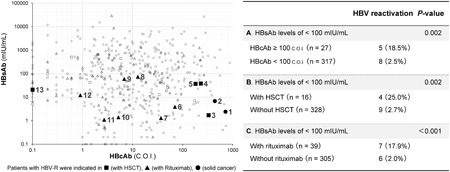 抄録全体を表示PDF形式でダウンロード (426K) HTML形式で全画面表示
抄録全体を表示PDF形式でダウンロード (426K) HTML形式で全画面表示
-
Yohei Takenaka, Ryu Tanaka, Kazuki Kitabatake, Fumiaki Uchiumi, Shin A ...2024 年 47 巻 5 号 p. 946-954
発行日: 2024/05/13
公開日: 2024/05/13
ジャーナル オープンアクセス HTMLThere is accumulating evidence that selective serotonin reuptake inhibitors (SSRIs), clinically used as antidepressants, have a beneficial effect on inflammatory diseases such as coronavirus disease 2019 (COVID-19). We previously compared the inhibitory effects of five U.S. Food and Drug Administration (FDA)-approved SSRIs on the production of an inflammatory cytokine, interleukin-6 (IL-6), and concluded that fluoxetine (FLX) showed the most potent anti-inflammatory activity. Here, we investigated the structure–activity relationship of FLX for anti-inflammatory activity towards J774.1 murine macrophages. FLX suppressed IL-6 production induced by the TLR3 agonist polyinosinic-polycytidylic acid (poly(I : C)) with an IC50 of 4.76 µM. A derivative of FLX containing chlorine instead of the methylamino group lacked activity, suggesting that the methylamino group is important for the anti-inflammatory activity. FLX derivatives bearing an N-propyl or N-(pyridin-3-yl)methyl group in place of the N-methyl group exhibited almost the same activity as FLX. Other derivatives showed weaker activity, and the N-phenyl and N-(4-trifluoromethyl)benzyl derivatives were inactive. The chlorine-containing derivative also lacked inhibitory activity against TLR9- or TLR4-mediated IL-6 production. These derivatives showed similar structure–activity relationships for TLR3- and TLR9-mediated inflammatory responses. However, the activities of all amino group-containing derivatives against the TLR4-mediated inflammatory response were equal to or higher than the activity of FLX. These results indicate that the substituent at the nitrogen atom in FLX strongly influences the anti-inflammatory effect.
 抄録全体を表示PDF形式でダウンロード (3901K) HTML形式で全画面表示
抄録全体を表示PDF形式でダウンロード (3901K) HTML形式で全画面表示 -
Zhiming Liu, Guangmei Xie, Zuwei Li, Hanbin Luo, Jianhong Zhou, Jie Ch ...2024 年 47 巻 5 号 p. 955-964
発行日: 2024/05/15
公開日: 2024/05/15
[早期公開] 公開日: 2024/04/20ジャーナル フリー HTML
電子付録The occurrence of in-stent restenosis (ISR) poses a significant challenge for percutaneous coronary intervention (PCI). Thus, the promotion of vascular reendothelialization is essential to inhibit endothelial proliferation. In this study, we clarified the mechanism by which Detoxification and Activating Blood Circulation Decoction (DABCD) promotes vascular reendothelialization to avoid ISR by miRNA-126-mediated modulation of the vascular endothelial growth factor (VEGF) signaling pathway. A rat model of post-PCI restenosis was established by balloon injury. The injured aortic segment was collected 14 and 28 d after model establishment. Our findings indicate that on the 14th and 28th days following balloon injury, DABCD reduced intimal hyperplasia and inflammation and promoted vascular reendothelialization. Additionally, DABCD markedly increased nitric oxide (NO) expression and significantly decreased ET-1 production in rat serum. DABCD also increased the mRNA level of endothelial nitric oxide synthase (eNOS) and the protein expression of VEGF, p-Akt, and p-extracellular signal-regulated kinase (ERK)1/2 in vascular tissue. Unexpectedly, the expression of miR-126a-5p mRNA was significantly lower in the aortic tissue of balloon-injured rats than in the aortic tissue of control rats, and higher miR-126a-5p levels were observed in the DABCD groups. The results of this study indicated that the vascular reendothelialization effect of DABCD on arterial intimal injury is associated with the inhibition of neointimal formation and the enhancement of vascular endothelial activity. More specifically, the effects of DABCD were mediated, at least in part, through miR-126-mediated VEGF signaling pathway activation.
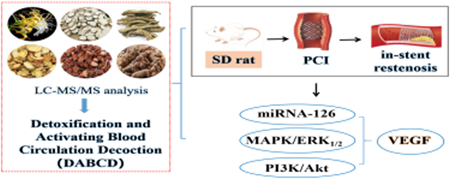 抄録全体を表示PDF形式でダウンロード (7873K) HTML形式で全画面表示
抄録全体を表示PDF形式でダウンロード (7873K) HTML形式で全画面表示
-
Yuka Kiba, Takashi Tanikawa, Masashi Kitamura2024 年 47 巻 5 号 p. 965-966
発行日: 2024/05/17
公開日: 2024/05/17
ジャーナル オープンアクセス HTML
電子付録The emergence of coronavirus disease 2019 (COVID-19), a novel identified pneumonia resulting from the severe acute respiratory syndrome coronavirus 2 (SARS-CoV-2) virus, has significantly impacted and posed significant challenges to human society. The papain-like protease (PLpro) found in the nonstructural protein 3 of SARS-CoV-2 plays a vital role in viral replication. Moreover, PLpro disrupts the host immune response by cleaving ubiquitin and interferon-stimulated gene 15 from host proteins. Consequently, PLpro has emerged as a promising drug target against SARS-CoV-2 infection. Computational studies have reported that ciclesonide can bind to SARS-CoV-2 PLpro. However, the inhibitory effects of ciclenoside on the PLpro have not been experimentally evaluated. Here, we evaluated the inhibitory effects of synthetic glucocorticoids (sGCs), including ciclesonide, on SARS-CoV-2 PLpro in vitro assay. Ciclesonide significantly inhibited the enzymatic activity of PLpro, compared with other sGCs and its IC50 was 18.4 ± 1.89 µM. These findings provide insights into the development of PLpro inhibitors.
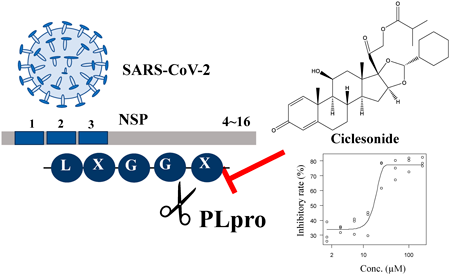 抄録全体を表示PDF形式でダウンロード (337K) HTML形式で全画面表示
抄録全体を表示PDF形式でダウンロード (337K) HTML形式で全画面表示
-
Ayato Mizuno, Tomoki Nakayoshi, Koichi Kato, Eiji Kurimoto, Akifumi Od ...2024 年 47 巻 5 号 p. 967-977
発行日: 2024/05/17
公開日: 2024/05/17
ジャーナル オープンアクセス HTML
電子付録Ensitrelvir is a noncovalent inhibitor of the main protease (Mpro) of severe acute respiratory syndrome coronavirus 2. Acquisition of drug resistance in virus-derived proteins is a serious therapeutic concern, and drug resistance occurs due to amino acid mutations. In this study, we computationally constructed 24 mutants, in which one residue around the active site was replaced with alanine and performed molecular dynamics simulations to the complex of Mpro and ensitrelvir to predict the residues involved in drug resistance. We evaluated the changes in the entire protein structure and ligand configuration in each of these mutants and estimated which residues were involved in ensitrelvir recognition. This method is called a virtual alanine scan. In nine mutants (S1A, T26A, H41A, M49A, L141A, H163A, E166A, V186A, and R188A), although the entire protein structure and catalytic dyad (cysteine (Cys)145 and histidine (His)41) were not significantly moved, the ensitrelvir configuration changed. Thus, it is considered that these mutants did not recognize ensitrelvir while maintaining Mpro enzymatic activities, and Ser1, Thr26, His41, Met49, Leu141, His163, Glu166, Val186, and Arg188 may be related to ensitrelvir resistance. The ligand shift noted in M49A was similar to that observed in M49I, which has been shown to be experimentally ensitrelvir resistant. These findings suggest that our research approach can predict mutations that incite drug resistance.
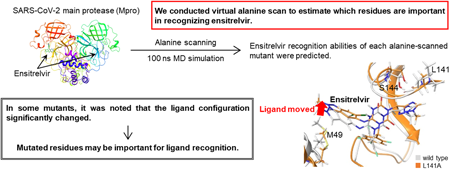 抄録全体を表示PDF形式でダウンロード (5833K) HTML形式で全画面表示
抄録全体を表示PDF形式でダウンロード (5833K) HTML形式で全画面表示 -
Yanxue Wang, Liang Li, Lingling Chen, Jinlei Xia, Tongli Wang, Lei Han ...2024 年 47 巻 5 号 p. 978-987
発行日: 2024/05/18
公開日: 2024/05/18
[早期公開] 公開日: 2024/04/18ジャーナル フリー HTMLNonalcoholic steatohepatitis (NASH) is a subtype of nonalcoholic fatty liver disease (NAFLD) characterized by hepatic steatosis and evidence of hepatocyte injury (ballooning) and inflammation, with or without liver fibrosis. In this study, after 12 weeks of induction, the mice were treated with emodin succinyl ethyl ester (ESEE) for four weeks at doses of 10/30/90 mg/kg/d. The blood analysis of experimental endpoints showed that ESEE exhibited significant therapeutic effects on the progression of disorders of glycolipid metabolism and the induced liver injury in the model animals. Histopathological diagnosis of the liver and total triglyceride measurements revealed that ESEE had a significant therapeutic effect on the histopathological features of nonalcoholic fatty liver disease/hepatitis, such as cellular steatosis and activation of intrahepatic inflammation. Additionally, ESEE was able to improve hepatocyte fat deposition, steatosis, and the course of intrahepatic inflammatory activity. Furthermore, it showed some inhibitory effect on liver fibrosis in the model animals. In summary, this study confirms the therapeutic effects of ESEE on the NAFLD/NASH model in C57BL/6J mice induced by a high-fat, high cholesterol, and fructose diet. These effects were observed through improvements in liver function, inhibition of fibrosis, and inflammatory responses. Changes in blood glucose levels, blood lipid metabolism, liver histopathological staining, liver fibrosis staining, and related pathological scores further supported the therapeutic effects of ESEE. Therefore, this study has important implications for the exploration of novel drugs for nonalcoholic fatty liver disease.
 抄録全体を表示PDF形式でダウンロード (6584K) HTML形式で全画面表示
抄録全体を表示PDF形式でダウンロード (6584K) HTML形式で全画面表示
-
Yuko Morinaga, Ryota Tanaka, Ryosuke Tatsuta, Kuniko Takano, Takehiro ...2024 年 47 巻 5 号 p. 988-996
発行日: 2024/05/18
公開日: 2024/05/18
ジャーナル フリー HTMLPatients with hematological malignancies (HM) often receive tazobactam/piperacillin (TAZ/PIPC) and glycopeptide antibiotics for febrile neutropenia. The effect of concomitant use of TAZ/PIPC on risk of teicoplanin (TEIC)-associated acute kidney injury (AKI) remains unclear. We investigated the impact of concomitant TAZ/PIPC use on TEIC-associated AKI in HM patients and identified the risk factors. In this retrospective, single-center, observational cohort study, 203 patients received TEIC, 176 of whom satisfied the selection criteria and were divided into TEIC cohort (no TAZ/PIPC; n = 118) and TEIC + TAZ/PIPC cohort (n = 58). AKI was defined as serum creatinine increase ≥0.3 mg/dL within 48 h or ≥50% from baseline. Incidence of AKI in TEIC cohort before and after propensity score matching was 9.3 and 5.9%, respectively, and that in TEIC + TAZ/PIPC cohort was 10.3 and 11.8%. AKI incidence and risk were not significantly different between two cohorts before (p = 0.829; odds ratio (OR) 1.122, 95% confidence interval (CI) 0.393–3.202) and after matching (p = 0.244; OR 2.133, 95% CI 0.503–9.043). Logistic regression analysis with factors clinically or mechanistically potentially related to TEIC-associated AKI, including concomitant TAZ/PIPC use, as independent variables identified baseline hemoglobin level as the only significant risk factor for TEIC-associated AKI (p = 0.011; OR 0.484, 95% CI 0.276–0.848). In HM patients treated with TEIC, concomitant TAZ/PIPC use did not increase AKI risk whereas lower hemoglobin levels had higher risk for TEIC-associated AKI development, suggesting the necessity to monitor serum creatinine when using TEIC in patients with anemia.
 抄録全体を表示PDF形式でダウンロード (379K) HTML形式で全画面表示
抄録全体を表示PDF形式でダウンロード (379K) HTML形式で全画面表示 -
Makiko Fujii, Kohsuke Shibasaki, Kaname Hashizaki, Hiroyuki Taguchi2024 年 47 巻 5 号 p. 997-999
発行日: 2024/05/21
公開日: 2024/05/21
ジャーナル オープンアクセス HTMLPatch tests are often used in safety evaluations to identify the substance causing skin irritation, but the same substance can sometimes give positive or negative results depending on the test conditions. Here, we investigated differences in the skin penetration of two test compounds under different application conditions. We studied the effects of the anionic surfactant sodium dodecyl sulfate (SDS) and the nonionic surfactant polysorbate 80 (PS) on skin penetration of the preservatives methylisothiazolinone (MT) and methylchloroisothiazolinone (MCT), which are used in cosmetics such as shampoos. The skin permeation of MT was enhanced by SDS but was unchanged by PS. Skin impedance decreased in the presence of SDS whereas PS had the same effect as the control aqueous solution, suggesting that SDS reduction of the barrier function of skin affects the permeation of MT, a hydrophilic drug. Application of a mixture of MCT and MT in the presence of SDS did not affect the skin permeation of MCT whereas the permeation of MT was enhanced by SDS, indicating that the skin permeation of MCT is less affected by SDS than is MT. Thus, attention should be paid to the possible effect of co-solutes, especially hydrophilic drugs.
 抄録全体を表示PDF形式でダウンロード (345K) HTML形式で全画面表示
抄録全体を表示PDF形式でダウンロード (345K) HTML形式で全画面表示
-
Hirofumi Ogino, Koichi Murano, Tomofumi Okuno, Hitoshi Ueno2024 年 47 巻 5 号 p. 1000-1007
発行日: 2024/05/21
公開日: 2024/05/21
ジャーナル フリー HTMLPreviously, insulin resistance and hepatic oxidative stress with increased expressions of glutathione peroxidase (GPx) 1 and selenoprotein P (SelP) were induced in NSY mice, a diabetic mouse model, by administrating a high fat diet (HFD) and seleno-L-methionine (SeMet) for 12 weeks. In this study we developed an analysis method for serum selenoproteins using LC-tandem mass spectrometry (LC-MS/MS) and investigated the effects of supplementary selenium on serum concentrations of selenoproteins as well as protein expression in skeletal muscle as a major insulin target tissue under the same experimental condition. The glucose area under the curves for oral glucose tolerance and insulin tolerance tests indicated that the HFD induced insulin resistance, whereas the treatment of SeMet + HFD showed insignificant promotion compared with the HFD-induced insulin resistance. Although the expressions of GPx1 in gastrocnemius and soleus were not significantly induced by supplementary SeMet nor HFD administration, the expressions of SelP in both skeletal muscles were significantly induced by the treatment of SeMet + HFD. There were also significant increases in serum concentrations of SelP by supplementary SeMet + HFD administration, whereas GPx3 was augmented by supplementary SeMet only. These results indicated that the HFD intake under the sufficient selenium status augmented the blood secretion of SelP, which may participate in the reduction of insulin sensitivity in skeletal muscles as well as liver or adipose tissues, and it is a better indicator of deterioration than GPx3 as it is a major selenoprotein in serum.
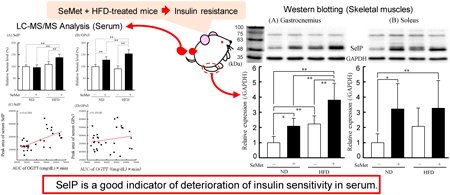 抄録全体を表示PDF形式でダウンロード (4100K) HTML形式で全画面表示
抄録全体を表示PDF形式でダウンロード (4100K) HTML形式で全画面表示
- |<
- <
- 1
- >
- >|